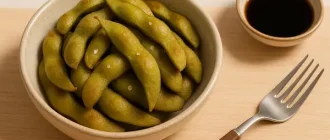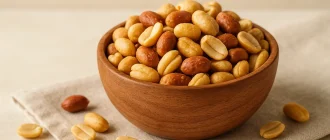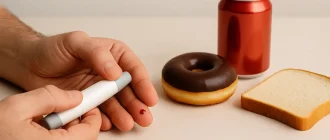Trans fats, also called trans–unsaturated fatty acids, are a type of fat produced through hydrogenation — a chemical process that adds hydrogen to vegetable oils, making them more solid. Unlike naturally occurring fats, trans fats are artificial and, frankly, not your body’s best friend. They increase LDL cholesterol (the “bad” kind) and decrease HDL cholesterol (the “good” kind). This combination raises the risk of heart disease, stroke, and type 2 diabetes.
In the United States, the FDA banned partially hydrogenated oils (the main source of artificial trans fats) in 2018, but small amounts are still found in certain foods.
How Trans Fat Goes From Factory to Your Plate
Simple steps to spot and avoid artificial trans fats when shopping and eating out.
1) Hydrogenation 🧪
Vegetable oils are hydrogenated to turn more solid and last longer on shelves.
- Goal: texture & shelf life
- Outcome: creates artificial trans fats
2) Added to Foods 🍪
Used for flaky pastries, creamy frostings, cheap frozen pizza, and some deep-frying.
- Why: crispy, creamy, inexpensive
- Watch: low-cost snacks & pastries
3) Label Loophole 🏷️
“0 g trans fat” can appear if a serving has < 0.5 g. Multiple small servings add up.
- Scan ingredients for partially hydrogenated oils (PHOs)
- Check serving size math
4) What This Means ⚠️
Even trace amounts matter when portions stack up. Prefer products with no PHOs at all.
- Swaps: air-popped popcorn, homemade thin-crust pizza
- Better oils: olive, avocado, high-oleic
A Brief History of Trans Fats in the American Diet
Trans fats weren’t always seen as villains. In fact, margarine was marketed in the mid-20th century as a healthier, modern alternative to butter. By the 1980s and 1990s, trans fats were everywhere — from fried chicken to snack cakes — mainly because they were cheap, shelf-stable, and gave food that irresistible flaky or creamy texture. Then the science piled up. Labeling for trans fat hit Nutrition Facts in 2006, sparking massive reformulations across the food industry. By 2015, the FDA determined that partially hydrogenated oils (PHOs) are not GRAS (not “generally recognized as safe”), and compliance milestones effectively phased PHOs out of the U.S. food supply by 2018 and beyond ⧉.
By the numbers (U.S.): According to FDA estimates, average trans fat intake fell about 78% from 4.6 g/day in 2003 to roughly 1.0 g/day in 2012 — a dramatic drop tied to labeling, local restaurant policies, and reformulation ⧉. Biomarker data back this up: analyses of NHANES samples show blood plasma trans fats fell ~52.5% between 1999–2000 and 2009–2010, reflecting real-world dietary change ⧉.
Translation? The American diet has come a long way — but trace amounts can still show up (hello, rounding rules and imported products), so staying label-savvy remains a no-brainer.
Where Do Trans Fats Hide in Everyday Foods?
Even though restrictions have reduced their use, trans fats continue to lurk in everyday meals. Some of the most common offenders include:
- Packaged baked goods (cookies, cakes, pies, pastries)
- Microwave popcorn (especially butter-flavored varieties)
- Frozen pizzas (thicker crust and cheaper brands)
- Margarine and shortening (although many have been reformulated)
- Fast food fried items (French fries, fried chicken, donuts)
- Non-dairy coffee creamers
In short: if it’s crunchy, creamy, or comes wrapped in shiny packaging, there’s a chance it contains trans fats.
How Much Trans Fat Is Too Much?
Here’s the kicker — no amount of trans fat is considered safe. The American Heart Association recommends keeping intake as close to 0 grams (0 g / 0 oz) as possible. The tricky part is labeling: in the U.S., a product can claim to have “0 g trans fat” if it contains less than 0.5 g (≈0.02 oz) per serving. That means eating several servings can quickly add up. Think of it like topping off your soda glass again and again — eventually, it’s more than just a sip. And yes, that “0 g” claim is allowed under FDA rounding rules (less than 0.5 g per serving rounds to zero) — so the fine print really matters ⧉.
Label-Reading 101 for Shoppers
To stay ahead, consumers should read ingredient lists carefully. The red flag? “Partially hydrogenated oil.” Even if the nutrition facts say “0 g,” the ingredients list may reveal the truth. Reyus Mammadli, a medical consultant, advises: “Always look past the bold numbers on the label and scan the fine print — that’s where trans fats like to hide.” Some common grocery items where this trick shows up: cheap frostings, boxed pie crusts, and budget frozen meals ⧉.
Restaurant and Fast Food Reality Check
Even after the FDA ban, not every meal cooked outside your kitchen is automatically trans-fat–free. Independent diners, small bakeries, and specialty import items can still contribute trace amounts. Ask what oil is used for frying, and be extra cautious with laminated doughs, frostings, and deep-fried staples. The good news is that policy works: after New York City restricted artificial trans fats in restaurants, mean trans fat per fast-food purchase dropped by 2.4 g between 2007 and 2009 — a big swing without a matching bump in saturated fat ⧉. Real talk: you can feel the difference in your arteries — not just in the crunch.
Healthy Alternatives and Smart Swaps
The good news? Every trans-fat-heavy item has a healthier cousin:
- Microwave popcorn (0.3–0.5 g ≈0.01–0.02 oz) → Swap for air-popped popcorn.
- Frozen pizza (0.4 g ≈0.014 oz) → Try homemade thin-crust pizza with olive oil.
- Packaged cookies (0.2–0.4 g ≈0.007–0.014 oz) → Go for whole-grain or homemade cookies.
- Non-dairy creamer (0.2–0.5 g ≈0.007–0.018 oz) → Use organic milk or oat creamer.
- Fast food fries (0.3–0.6 g ≈0.01–0.02 oz) → Bake potato wedges at home.
As Reyus Mammadli notes: “Replacing one food item at a time makes the shift easier — swap butter-flavored popcorn for air-popped, and you’ve already cut trans fat.”
Trends in the U.S. Food Industry
Food companies and restaurants continue to respond to consumer demand for healthier choices. Major fast-food chains phased out partially hydrogenated oils years ago, and supermarket brands now highlight “0 g trans fat” and “no partially hydrogenated oils.” In October 2024, FDA reiterated its final determination that PHOs are not GRAS and moved to clean up residual legacy approvals — keeping the U.S. supply essentially PHO-free ⧉. Globally, the WHO reported fresh progress in 2024, recognizing additional countries for best-practice elimination policies — a nudge that also benefits U.S. consumers through safer imports ⧉.
What’s next? Expect more snacks and restaurant items touting high-oleic or avocado oil, plus cleaner labels that spell out “zero partially hydrogenated oils.” That’s the move — and for shoppers, it’s a hard pass on anything still listing PHOs.
Editorial Advice
Trans fats may not dominate headlines like they used to, but they remain a sneaky danger in the American diet. The safest path is avoiding packaged and fried foods whenever possible. Stick to fresh, whole foods, read labels carefully, and don’t fall for “0 g trans fat” marketing tricks. As Reyus Mammadli, medical consultant, emphasizes: “The small print often speaks louder than the big claims.” A heart-healthy lifestyle doesn’t demand perfection, but it does require paying attention — and your arteries (and your waistline) will thank you for it.
About the Author
Reyus Mammadli is the author of this health blog since 2008. With a background in medical and biotechnical devices, he has over 15 years of experience working with medical literature and expert guidelines from WHO, CDC, Mayo Clinic, and others. His goal is to present clear, accurate health information for everyday readers — not as a substitute for medical advice.







